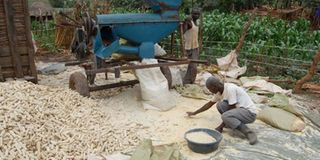You could be jailed, fined for poor quality maize in Nakaseke

Farmers mill and pack maize on a farm. FILE PHOTO
Whoever produces or deals in poor quality maize in Nakaseke District could face a jail term of up to eight weeks, as per an ordinance that was passed by the district council. It also provides for a fine and a room for the offender to serve the jail term as well as pay the fine, where it is deemed fit.
This is the first time that an ordinance—a law enacted by a district or at local government level—is formulated specifically for maize production and trade.
The development has excited players in grain industry, who say there should be similar initiatives across the country. This should be alongside implementation of the National Grain Policy, which was passed last month by the Cabinet. The ministry of trade the implementation and enforcement of the policy to cost Shs2.6b.
The ordinance is an effort to enforce standards and best practices among farmers and traders operating within Nakaseke, which is one of the largest maize-producing districts in the central region.
Ignatius Koomu Kiwanuka, the district chairman, says they took this measure (making a law for maize) to deal with the widespread flouting of maize standards across the value chain; endangering the consumers as well as hurting markets in the district and beyond.
“In accordance with Section 38 of the Local Governments Act, Cap 243, Nakaseke District has enacted the ordinance on maize standards titled, Nakaseke District (Local Government) (Maize) Ordinance 2015,” Kiwanuka announced at the signing of the ordinance. “This will help to develop and regulate the maize industry in the district and ensure production of quality maize that meets set market standards.”
It stipulates the acceptable production practices such as proper agronomic and post-harvest handling practices as well as marketing procedures including registration of dealers in maize, and approved procedures of proper storage, milling and transportation.
“One of the key causes of Uganda’s low penetration levels into the formal maize markets at regional and international levels is the poor quality of maize produced in the country that does not meet expected market standards,” remarked Nathan Irumba, the chief executive officer, South and Eastern African Trade Information and Negotiations Institute (Seatini).
Cure the ills
This was at the same occasion where the ordinance was signed.
Irumba adds, “As a result, there have been incidents where Uganda’s maize has been rejected by trading partners. In 2013, Tanzania rejected 15,000 metric tonnes of maize from Uganda citing concerns about its quality. So, this ordinance, if implemented, will improve quality of Uganda’s maize.”
David Luseesa, the programme manager, Grain Council of Uganda, said alongside the national grain policy, “the ordinance will cure the ills the sector is grappling with across the region.
Maize farmers and industry representatives agree that the prevalence of poor maize standards is a result of gaps in policy, which provide a leeway for some farmers and traders to engage in unscrupulous practices. Some of these are spraying maize with chemicals to speed up drying and mixing good with diseased, broken or rotten grains at the mills.
Studies cited by Seatini Uganda, who supported development and dissemination of the Nakaseke ordinance, indicate that poor post-harvest handling affects quality and safety of the maize. This was highlighted as a rampant problem in Nakaseke District.
Moist conditions arising from poor storage leads to contamination of grains, making it hazardous for human and animal consumption.
Implementation will enhance maize production and enable better incomes and improved health and safety, in addition to increasing the country’s maize exports.
It is important for other districts to replicate this ordinance given its immense benefits to the people and the economy.
Background
The Nakaseke District ordinance on maize was developed through a consultative and participatory process. It involved farmers, traders, local leaders, district officials and representatives of community development organisations from the village to district level.
The participatory process ensured ownership of the ordinance.
This will ease its implementation and application by all stakeholders involved in the maize value chain in Nakaseke District.
It should be noted that Uganda has a wide market opportunity for maize export especially within the East African Community.
Currently, the national standard storage facilities for maize can cater for only 550,000 metric tonnes out of 3.2 million which is the total annual production, according to figures from ministry of Agriculture.
As a result of the inadequate storage facilities and poor post-harvest handling practices, the country is struggling to compete in the grain market.
Uganda’s export potential is estimated between 200,000 and 250,000 metric tonnes of maize per annum, yet studies, according to the South and Eastern African Trade Information and Negotiations Institute (Seatini), Uganda only exports half of this amount.
This is despite the fact that there is a high demand for maize in the region with Kenya’s annual consumption alone estimated at about 3,670,000 metric tonnes with a supply deficit of about 600,000 metric tonnes.
There is also huge market potential for maize at national level and also beyond the East African regional trade bloc.




